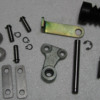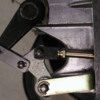quote:
Originally posted by lastpushbutton:
I pushed mine with the tranny on the table and did not have to disengauge the clutch too. You won't be moving anything with it installed. That's why I think It may not be a big diff. Anything would help. When I bought the first Centerforce I was expecting a big diff but My leg still cramps in traffic.

I actually think that those springs are to make sure that the throwout bearing fully returns to the home position.
The Center Force is lighter then what was in my car when I got it. It would be interesting to read pedal pressure differences from car to car and clutch to clutch.
I think in one of the Ford shop manuals, maybe the Lincoln Versalles, the brake pedal pressure gets measured in order to verify it is within design specs.
I know that from working on a lot of Ford Power brake systems from the '70s that the brake pedal was considered correct if you could put your other foot under it while applying the brakes.
I don't remember seeing a number on any clutches , ever, but that is an interesting thought.
I'd bet you a bright shinny nickel Billy that the Center Force is something like 30% lighter then the original Long three finger in the car?
No one ever said that would be as light as a VW Beetle. Bill. Your leg doesn't cramp with that one too does it?




